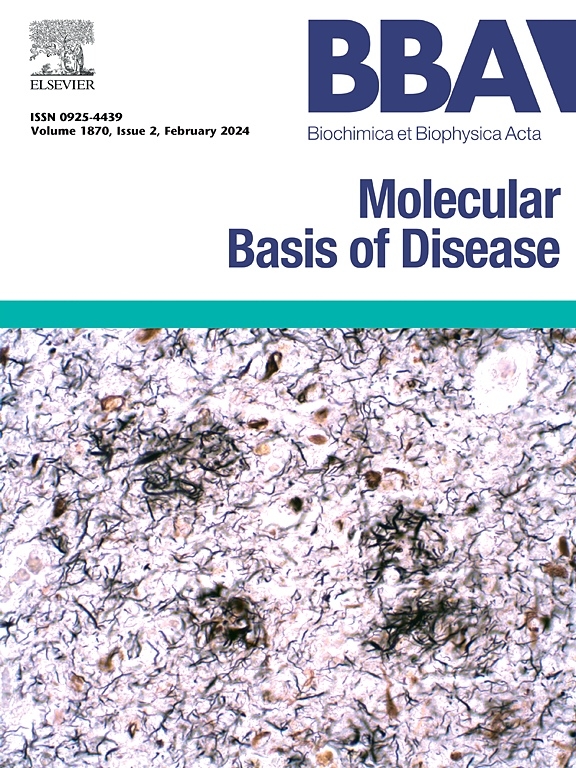Dysfunctional RNA binding protein induced neurodegeneration is attenuated by inhibition of the integrated stress response
IF 4.2
2区 生物学
Q2 BIOCHEMISTRY & MOLECULAR BIOLOGY
Biochimica et biophysica acta. Molecular basis of disease
Pub Date : 2024-11-07
DOI:10.1016/j.bbadis.2024.167562
引用次数: 0
Abstract
Dysfunction of the RNA binding protein heterogeneous nuclear ribonucleoprotein A1 (hnRNP A1) contributes to neurodegeneration, the primary cause of permanent disability in multiple sclerosis (MS). To better understand the role of hnRNP A1 dysfunction in the pathogenesis of neurodegeneration, we utilized optogenetics-driven hnRNP A1 clustering to model its dysfunction in neuron-like differentiated Neuro-2A cells. hnRNP A1 clustering activates the integrated stress response (ISR) and results in a neurodegenerative phenotype marked by decreased neuronal protein translation and neurite loss. Small molecule inhibition of the ISR with either PERKi (GSK2606414) or ISRIB (integrated stress response inhibitor) attenuated both the decrease in neuronal translation and neurite loss, without affecting hnRNP A1 clustering. We then confirmed a strong association between hnRNP A1 clustering and ISR activation in neurons from MS brains. These data illustrate that hnRNP A1 dysfunction promotes neurodegeneration by activation of the ISR in vitro and in vivo, thus revealing a novel therapeutic target to reduce neurodegeneration and subsequent disability in MS.
抑制综合应激反应可减轻功能失调 RNA 结合蛋白诱导的神经退行性变。
RNA 结合蛋白异质核核糖核蛋白 A1(hnRNP A1)的功能障碍导致神经变性,而神经变性是多发性硬化症(MS)造成永久性残疾的主要原因。为了更好地了解 hnRNP A1 功能障碍在神经退行性变发病机制中的作用,我们利用光遗传学驱动的 hnRNP A1 聚类来模拟神经元样分化 Neuro-2A 细胞中的功能障碍。用 PERKi(GSK2606414)或 ISRIB(综合应激反应抑制剂)小分子抑制 ISR 可减轻神经元翻译的减少和神经元的丢失,而不影响 hnRNP A1 的聚集。我们随后证实了多发性硬化症大脑神经元中 hnRNP A1 聚类与 ISR 激活之间的密切联系。这些数据说明,hnRNP A1 功能障碍通过激活体外和体内的 ISR 促进神经退行性变,从而揭示了减少多发性硬化症神经退行性变和后续残疾的新型治疗靶点。
本文章由计算机程序翻译,如有差异,请以英文原文为准。
求助全文
约1分钟内获得全文
求助全文
来源期刊
CiteScore
12.30
自引率
0.00%
发文量
218
审稿时长
32 days
期刊介绍:
BBA Molecular Basis of Disease addresses the biochemistry and molecular genetics of disease processes and models of human disease. This journal covers aspects of aging, cancer, metabolic-, neurological-, and immunological-based disease. Manuscripts focused on using animal models to elucidate biochemical and mechanistic insight in each of these conditions, are particularly encouraged. Manuscripts should emphasize the underlying mechanisms of disease pathways and provide novel contributions to the understanding and/or treatment of these disorders. Highly descriptive and method development submissions may be declined without full review. The submission of uninvited reviews to BBA - Molecular Basis of Disease is strongly discouraged, and any such uninvited review should be accompanied by a coverletter outlining the compelling reasons why the review should be considered.

 求助内容:
求助内容: 应助结果提醒方式:
应助结果提醒方式:


